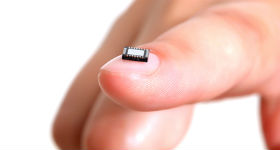Back in 1965, Intel co-founder Gordon Moore predicted that the number of components in an integrated circuit would double every year. He revised his benchmark in 1975 to a doubling of components every two years. For nearly 40 years, Intel managed to keep pace to what has become a cliché—Moore's Law—but 2015 marks the end of a beautiful run.
At Intel's second quarter financial call this week, CEO Brian Krzanich stated the obvious to keen observers: The company's last technology doubling took nearly two and a half years, rather than the "rule" of two years. Intel's latest generation of 14-nanometer (nm) technology took more time than expected while the next notch to 10-nm is to be launched in 2017, almost three years later.
Purists and sticklers will note there's been a lot of fudging over what Moore's Law has and hasn't predicted over the past 50 years, but true appreciation comes when you look at the sheer number of engineering rabbits-out-of-the-hat improvements that have taken place over the decades in order for the silicon chip industry to continue to improve and innovate.
The U.S. government and private industry started worrying about limits to basic photolithographic etching processes for making chips back in the 1980s. A mix of public and private money has gone into investigating extreme ultraviolet (EUV) and X-ray processes over 40 years, but only recently has EUV demonstrated the ability to deliver the price/performance necessary to displace photolithography.
 Image via Shutterstock
Image via Shutterstock
IBM last week announced it had produced working samples of chips with 7-nanometer transistors using EUV and silicon-germanium, representing the next step beyond 10-nm. TSMC believes EUV will be "qualified" to produce 7-nm chips in 2017, but essential to go down to 5-nm in the future, with large scale production use occurring in 2020. Many questions remain around EUV, including if the technology can support high-speed chip production, but billions of dollars are going into sub-10-nm tech.
The net-net here is that the photolithographic tech dating back to the original silicon integrated circuits made in the 1960s and 1970s has been optimized and tricked out and squeezed to continue to work for at least the next generation of chips set down to 10-nm.
How far down Moore's Law can hold is a subject of some speculation. There is a clear path to 5-nm technology by 2020 or so. Future improvements may include 3D circuits and a migration away from all silicon to silicon-germanium and other materials for chips.
Another path for improvement may be in the underlying architecture for CPUs. IBM's neurosynaptic chip mimics how the human brain analyzes patterns and recognizes shapes and colors. Tapping into neural-network chips that use many smaller processors for tasks that strain traditional computer architecture and integrating them with existing devices may be the next big thing in the 2020s and beyond.
Edited by
Dominick Sorrentino